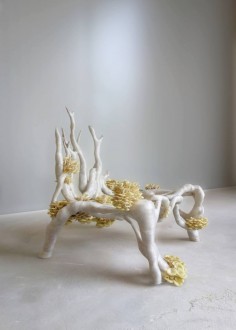ERIC KLARENBEEK
mycelium chair
source: dezeen
Dutch Design Week 2013: designer Eric Klarenbeek has 3D-printed a chair using living fungus, which then grows inside the structure to give it strength.
The chair is the result of a collaboration between Klarenbeek and scientists at the University of Wageningen to develop a new way of printing with living organisms. “Our main purpose was to bring together the machine and nature to create a new material that could be used to make any product,” Klarenbeek told Dezeen.
The result is a new material that, Klarenbeek believes, could be used to make almost anything in future. “It could be a table, a whole interior or even a house,” he said. “We could build a house with it.”
3D-printed segment of bioplastic shell
Presented at Dutch Design Week in Eindhoven this weekend, the Mycelium Chair was printed using a mixture of water, powdered straw and mycelium, which is the thread-like part of a fungus that lives underground.
The mycelium grew within the structure, replacing the water and creating a solid but extremely lightweight material. Mushrooms began sprouting on the surface, at which point Klarenbeek dried out the structure to prevent further growth.
“When you dry it out you have the straw kind of glued together by the mushroom,” Klarenbeek said. “You have this strong, solid material that is really lightweight and durable.”
A thin layer of printed bioplastic covers the structure of the chair to contain the growing fungus. Straw was used as a substrate since the fungus used in the project – the yellow oyster mushroom – likes to grow on straw.
“The mushrooms are only a decorative element,” said Klarenbeek. That’s why we shot the photograph with the mushrooms popping out. Our main purpose was to bring together the machine and nature to create a new material that could be used to make any product.
“This chair is really a metaphor for what could be made with this technique of 3D printing a living organism and then have it grow further. It could be a table, a whole interior or even a house. We could build a house with it.”
Designer Eric Klarenbeek interest is combining materials in unexpected ways. Klarenbeek is exploring ways of making 3D prints of living organisms, such as mycelium, the threadlike network in fungi.
He uses experimental raw materials for printing material: organic substrate for mushroom growing and bioplastics. Working with scientists, Klarenbeek has printed a chair from straw, with a thin coating of bioplastic.
Once it is mature it should be strong enough to support a person. The chair is a metaphor for what can be achieved with materials and production methods.
.
.
.
.
.
.
.
source: ericklarenbeeknl
We’re crazy busy creating new stuff, so we decided to let you know more about our activities with a nicer and clearer website. It’s going to be way more dynamic, so we can upload stuff from our mobile phones and keep you updated. It’s now fully in process, so the website is renewing step by step, day by day. Thanks for following us.
Anyway, you want to know more about the studio, and what we are creating: We do special projects, or let’s say unusual, for unusual people, projects or purposes. We connect creatives, designers, local crafts and you by inventing new projects and products and believe our world can be so much better, more beautiful and honest.
.
.
.
.
.
.
.
source: mongcz
设计师Eric klarenbeek与德国的Aachen大学的科学家合作开发出了菌丝椅子,这种椅子使用3D打印和生物体共同创建,形成了如真菌一样的丝状网络。
Eric Klarenbeek的兴趣在于,以人们意想不到的方式把不同的材料结合起来。他用作实验的原料:种植的有机蘑菇和生物塑料—–作为3D打印的材料。他与科学家一起努力, Klarenbeek已经开发了一种新的生物组织3D打印方式。菌丝椅子是把水,稻草粉末和菌丝体混合起来,并且用3D打印出来,并且涂了层薄的生物塑料。
然后,菌丝体开始在稻草的结构内生长。一旦它完全长大,它的最终结构变得坚实和强大,足以支持一个坐着的人。然后Klarenbeek把结构干燥,以防止它进一步的增长。菌丝体生长非常迅速,重量轻,耐火,而且结实耐用。 Klarenbeek认为,这可能是一个伟大的3D打印材料。
椅子只是揭示了我们能用什么样的材料和生产方法,Klarenbeek说 。他甚至认为,新材料可能做成任何产品,桌子,椅子,甚至整个房子。
.
.
.
.
.
.
.
.
source: blogelianesampaio
Em Eindhoven, na Holanda, Dutch Design Week 2013.
O holandês Eric Klarenbeek apresentou esta cadeira onde usou a combinação de impressão 3D e fungo vivo.
A ideia é que o fungo crescendo dentro da estrutura dará força à peça para sustentar uma pessoa.
.
.
.
.
.
.
source: print-unet
Il designer olandese Eric Klarenbeek ha recentemente realizzato una straordinaria sedia creata combinando materiali organici con la stampa 3D. In collaborazione con l’Università di Aachen, Klarenbeek ha sviluppato un innovativo metodo di stampa 3D che prevede l’utilizzo di cellule viventi. La sedia in questione si chiama “Mycelium Chair” ed è cosparsa di spore di funghi che fiorendo nel corso del tempo ne cambiano l’aspetto.
Per ottenere un materiale flessibile, il progettista ha estratto il micelio dai funghi utilizzando come base il materiale filiforme. Poi mescolando il micelio con un composto di paglia e acqua ha ottenuto una sostanza utilizzabile con una stampante 3D.


